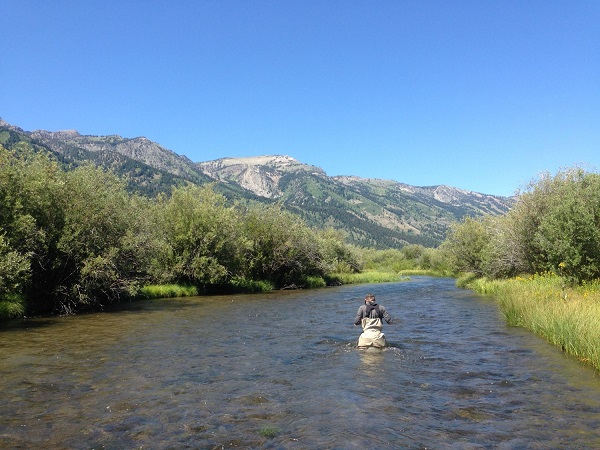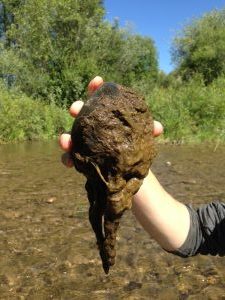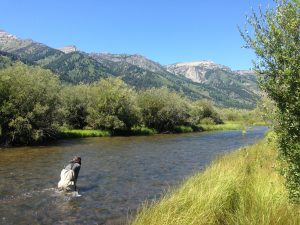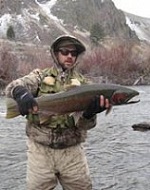Apply now to join our next cohort of Community Science Fellows and Community Leads!

 The Jackson, WY-TEX project was launched in Spring 2016, at a time when the Jackson, WY community was in need of outside expertise on an issue where they lacked clear direction: how to identify and address sources of nutrient contamination in Fish Creek. TEX matched Jackson with Dr. William (Bill) Elliot, a research engineer in the Air, Water and Aquatic Environments Science Program at USDA Forest Service and a member of AGU. Over the course of nearly 18 months, Bill and Carlin Girard, Water Resource Specialist at the Teton Conservation District, corresponded about the ongoing challenge in the community, nutrient sources and best management practices (BMPs), and the science behind them. Through their engagement – largely in the form of expert review and input on plans and information – Carlin and Bill were able to ensure that opportunities weren’t missed and that the community looked beyond internal conversations to think more broadly about the issue and different approaches to address it.
The Jackson, WY-TEX project was launched in Spring 2016, at a time when the Jackson, WY community was in need of outside expertise on an issue where they lacked clear direction: how to identify and address sources of nutrient contamination in Fish Creek. TEX matched Jackson with Dr. William (Bill) Elliot, a research engineer in the Air, Water and Aquatic Environments Science Program at USDA Forest Service and a member of AGU. Over the course of nearly 18 months, Bill and Carlin Girard, Water Resource Specialist at the Teton Conservation District, corresponded about the ongoing challenge in the community, nutrient sources and best management practices (BMPs), and the science behind them. Through their engagement – largely in the form of expert review and input on plans and information – Carlin and Bill were able to ensure that opportunities weren’t missed and that the community looked beyond internal conversations to think more broadly about the issue and different approaches to address it.
Carlin and Bill’s collaboration was discussion-based. Over the course of the collaboration, two USGS reports were reviewed detailing scientific investigations into the Fish Creek Nutrient Loading Issue: one was released prior to the beginning of the project in 2013, and the other during their discourse in 2016. Carlin forwarded these reports to Bill for review and discussion. They cited use of email as essential for communicating and sharing technical information.
 After information sharing and dialogue, Bill ultimately sent an extended memo to Carlin following the release of the new USGS report detailing 1) specific information to consider pertaining to the study itself and 2) how Jackson might implement BMPs to mitigate nutrient loads considering the local factors at play.
After information sharing and dialogue, Bill ultimately sent an extended memo to Carlin following the release of the new USGS report detailing 1) specific information to consider pertaining to the study itself and 2) how Jackson might implement BMPs to mitigate nutrient loads considering the local factors at play.
Carlin indicated that these products and other communications served to clarify and verify ideas and opportunities considered by the community to address Fish Creek’s nutrient issues. They were especially valuable coming from an unbiased, third-party reviewer. Carlin expressed that while Jackson has extremely dedicated and informed staff working on this issue, their small team of 3-4 people has been working together on this issue for, in some cases, nearly two decades. This can sometimes feel like operating in a vacuum. As a result, engaging with Bill proved to be extremely valuable: prior to bringing information to a larger stakeholder group comprised of local political, community and business leaders, Carlin and his team could vet their scientific information and identify potential shortcomings and issues in advance.
The Teton Conservation District is a non-regulatory body, and as such, it relies on science to expend funds and provide incentives. As a result of this collaboration with Bill, Carlin was able to present information to the stakeholder group with confidence and authority. This helped ensure that, despite unavoidable political and economic considerations, actions recommended by the stakeholder group were grounded in the best available science.
As local managers navigate the day-to-day challenges of their positions and the critical issues they must work to address, it can be difficult for them to be aware of the resources that might be available. Carlin reflected that programs like TEX can support the efforts of conservation districts all over the country. Two challenges for these local managers to overcome include 1) defining what problems they’re dealing with and what help they could use and 2) finding that help affordably. The right pro-bono support can be an invaluable resource.
Bill and Carlin reflected on what contributed to their success:
There were things that they would do differently:
When asked how they would advise other people pursuing similar community science projects, Bill expressed how important it is to understand the problem at hand. Too often, individuals consider the symptoms, but not the real problem. In this case, the symptom was the stream turning green. It’s important to work to understand what the problem is so you know what questions to ask and what answers you need. Take the time to build up communication.
Carlin recommended that communities look to define, inform and implement community science issues within a stakeholder framework. When addressing multi-stakeholder issues, it is extremely difficult to work one-on-one with different interest groups, and then to reach out to them once the science is done. Bring stakeholders together at the outset and include them in the decision-making process for a more transparent and effective effort.
Bill has reached out to colleagues at nearby universities to inform them of the work being done in Jackson. By informing colleagues of the community’s work to mitigate nutrient pollution in Fish Creek, he’s hoping that other scientists may have interest in starting a project in Jackson that will help Carlin and the stakeholder group further define and refine their work.
In the meantime, Bill hopes to travel to Jackson in the near future and meet Carlin in person.

Fish Creek and the Snake River Westbank aquifer are an important resource to the community of Jackson in Teton County, Wyoming. Unfortunately, in recent years there is greater evidence of nutrient pollution that threatens local water sources and their ecosystems.
The available evidence points to a number of sources for this nutrient contamination including a combination of agricultural runoff, landscape fertilizer, individual septic system waste, as well as treated wastewater. The US Geological Survey engaged in a study – released in 2016 – to more comprehensively determine the source and extent of these nutrient flows.
Jackson came to TEX seeking a scientific partner or partners to take the currently available data and work with local stakeholders in assessing best practice in managing these nutrient flows. The community wished to have this input ready for when the full nutrient loading study was released to ease the transition into stakeholder consensus and action.

Photo courtesy of Wikimedia Commons
The Fish Creek Stakeholders Group has recently begun to organize an internal scientific advisory committee. The goal of this group is to provide scientifically based opinions to inform remediation options for Fish Creek. Carlin Girard anticipates that Bill Elliot will be formally invited to be a part of this panel, seeing as his expertise and external perspective will add validity to the project. By the time the United States Geological Survey (USGS) releases their study of Fish Creek in July, the City of Jackson hopes to have the review panel assembled. Bill and Carlin are set to discuss the logistical details of what this would entail, including possible travel and other expectations.
 Carlin Girard is the Water Resource Specialist for the Teton Conservation District in Jackson, WY. Coming from a diverse background in natural resource management and research, his experience working for the Wyoming Game and Fish Department in Jackson led him to a Master’s degree in Aquatic Resource Management at the University of Wyoming. His aquatic work experience has focused on native fisheries, aquatic and riparian habitat, and water quality.
Carlin Girard is the Water Resource Specialist for the Teton Conservation District in Jackson, WY. Coming from a diverse background in natural resource management and research, his experience working for the Wyoming Game and Fish Department in Jackson led him to a Master’s degree in Aquatic Resource Management at the University of Wyoming. His aquatic work experience has focused on native fisheries, aquatic and riparian habitat, and water quality.
Dr. William (Bill) Elliot’s current research focuses on making complex watershed tools useful to watershed managers. He believes that a better understanding of watershed processes will enable provision of abundant clean water for people in the U.S. and throughout the world. His professional experience as a research civil engineer and his work with the USDA, US Forest Service, and Rocky Mountain Research Station have allowed him to contribute to that understanding.
(c) 2024 Thriving Earth Exchange